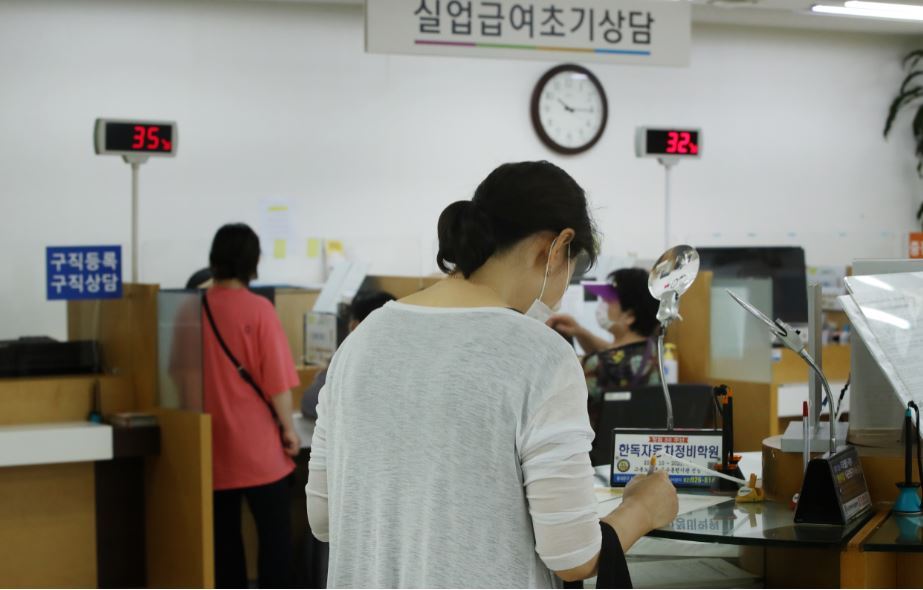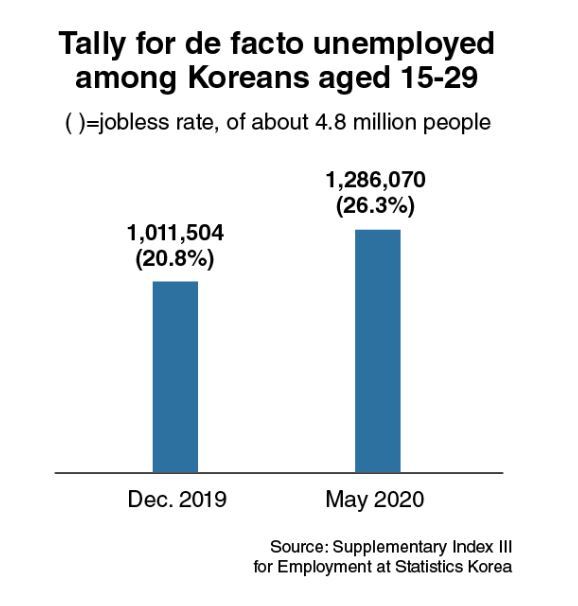[News Focus] Number of de facto jobless under 30 hits all-time high
Korea ranks 31st among 37 OECD members in youth employment
By Kim Yon-sePublished : July 12, 2020 - 16:42

SEJONG -- The tally of unemployed or underemployed young people in South Korea has reached a historic high in the wake of the novel coronavirus.
According to the Supplementary Index III for Employment, the number of de facto jobless (unemployed or underemployed) Koreans aged between 15 and 29 came to 1.28 million as of May. This marked the highest number since the nation began compiling the monthly data in January 2015.
They made up 26.3 percent of the 4.89 million economically active people in that age group.
The Index III provides a relatively new method of calculating unemployment, counting underemployed people among the de facto unemployed. This category, also called “extended-based” jobless, includes those who work fewer than 36 hours a week and want to work more, as well as seasonal workers who are out of work for part of the year.
The figure of 1.28 million was a sharp increase (by 27.1 percent) compared with the end of 2019, when the de facto jobless youth population stood at 1.01 million. The de facto jobless rate stood at 20.8 percent in December.
The data for May also outstripped the 1.26 million recorded in April and the 1.27 million posted in March -- though the de facto jobless rate, 26.3 percent, inched down by 0.3 percentage point from 26.6 percent for both April and March.

The COVID-19 disaster, which hit the nation in late January, is estimated to have slashed the number of temporary jobs in the services sector and prevented businesses from hiring new employees.
But unemployment among those under age 30 was already a critical social problem for several years before the pandemic started.
Though the Moon Jae-in administration vowed to create as many jobs as possible for those in their 20s, the percentage of de facto unemployed has remained above the 20 percent mark for the 37th consecutive month since Moon took office in May 2017.
While the government has promised to create many public sector jobs, a dominant portion of the positions it has created have been filled by those in their 60s -- not those in their 20s -- over the past three years, according to a variety of data.
The drastic hikes in the statutory minimum wage in 2018 and 2019 have frustrated small-business owners, who had to hire fewer part-time and regular employees as a result.
In May 2017, President Moon showcased an electronic dashboard to the media, which was set up in the presidential office for the purpose of monitoring the number of jobs created.
College students and other young citizens pinned high hopes on the new administration. But they have not seen the president pose beside the dashboard in recent months.
A certain portion of college students are saddled with debt from student loans, yet have few opportunities for regular employment.
Korea’s youth employment rate was far below the OECD average. While the average employment rate for those aged 15-24 was 42.3 percent across all 37 OECD members, the corresponding figure for Korea stood at 25.6 percent as of March 2020. Korea stood at No. 31 on the list, meaning 30 countries had higher youth employment rates.
The corresponding figures for young workers in the US (No. 20) and Japan (No. 12) came to 38.6 percent and 47.4 percent, respectively. Colombia (No. 19) and Mexico (No. 18) respectively posted employment rates of 38.6 percent and 41.6 percent for the 15-24 age bracket.
The respective average youth employment rates for the eurozone, EU and G7 were 33.9 percent, 35.8 percent and 46.6 percent.
Iceland topped the list with 68.8 percent, followed by the Netherlands with 65.9 percent, Switzerland with 61 percent, Australia with 60.1 percent, New Zealand with 57.7 percent and Canada with 54.9 percent.
By Kim Yon-se (kys@heraldcorp.com)


![[Exclusive] Korean military set to ban iPhones over 'security' concerns](http://res.heraldm.com/phpwas/restmb_idxmake.php?idx=644&simg=/content/image/2024/04/23/20240423050599_0.jpg&u=20240423183955)

![[Graphic News] 77% of young Koreans still financially dependent](http://res.heraldm.com/phpwas/restmb_idxmake.php?idx=644&simg=/content/image/2024/04/22/20240422050762_0.gif&u=)



![[Pressure points] Leggings in public: Fashion statement or social faux pas?](http://res.heraldm.com/phpwas/restmb_idxmake.php?idx=644&simg=/content/image/2024/04/23/20240423050669_0.jpg&u=)









